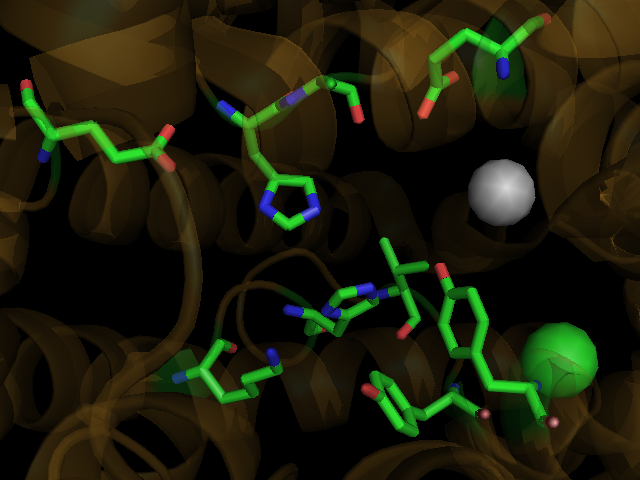Lisinopril-Angiotensin Converting Enzyme
From Proteopedia
| Line 1: | Line 1: | ||
| + | <Structure load='2iux' size='350' frame='true' align='right' caption='Human tACE' scene='Insert optional scene name here' /> | ||
Angiotensin Coverting Enzyme is an enzyme that is found in the renin system that converts the hormone angiotensin I into angiotensin II which affects blood pressure by regulating the volume of fluids. The drug Lisinopril is an Angiotensin Converting Enzyme Inhibitor. Which lowers the blood pressure in the body. | Angiotensin Coverting Enzyme is an enzyme that is found in the renin system that converts the hormone angiotensin I into angiotensin II which affects blood pressure by regulating the volume of fluids. The drug Lisinopril is an Angiotensin Converting Enzyme Inhibitor. Which lowers the blood pressure in the body. | ||
== Structure of Enzyme== | == Structure of Enzyme== | ||
| - | This enzyme | + | This enzyme, <scene name='81/815386/Angiotensin_converting_enzyme/1'>Angiotensin Converting Enzyme</scene> |
| + | type 1 membrane bound protein that has 28 residue C- terminal cytosolic domains as well as 22- residue hydrophobic transmembrane domains and it has 1227 residue extracellular domain. The extracellular domain has two more isoforms of ACE, which are N- domains and C-domains. The N-domain plays a role in hematopoietic stem cell differentiation and proliferation while C-domain is mainly involved in blood pressure regulation. In each of these domains are two histidine residues which are used to binding zinc ligands with glutamine to make the geometry tetrahedral. Through mutational analyses and detailed kinetics, it is clear that both zinc sites have activity which is considered to be catalytic <ref>Riordan, James F. “Angiotensin-I-converting enzyme and its relatives.” Genome biology vol. 4,8 (2003): 225. doi:10.1186/gb-2003-4-8-225</ref> | ||
[[Image: Binding_site.png]] | [[Image: Binding_site.png]] | ||
| Line 10: | Line 12: | ||
==Structure of Lisinopril== | ==Structure of Lisinopril== | ||
Lisinopril (S)-1-[(N^2-carboxyl-3-phenylpropyl]-L-lysyl-L-proline diyhdrate) is a drug that is used to inhibit ACE and to treat hypertension, congestive heart failure and improve survival after a heart attack. Its molecular formula is C21 H31 N3 O5. | Lisinopril (S)-1-[(N^2-carboxyl-3-phenylpropyl]-L-lysyl-L-proline diyhdrate) is a drug that is used to inhibit ACE and to treat hypertension, congestive heart failure and improve survival after a heart attack. Its molecular formula is C21 H31 N3 O5. | ||
| - | + | [[Image:Lisinopril.png]] | |
= Mechanism of Action= | = Mechanism of Action= | ||
Lisinopril works by preventing the conversation of angiotensin I to angiotensin II. When there is a decrease in angiotensin II, it causes a reduction in aldosterone section and this in turn causes a decrease in sodium reabsorption within the collecting ducts as well as decrease potassium excretion. In the end by removing the negative feedback of angiotensin II, the drug can lead to an increase in serum renin activity. <ref>Olvera Lopez E, Terrell JM. Lisinopril. [Updated 2019 Jan 20]. In: StatPearls [Internet]. Treasure Island (FL): StatPearls Publishing; 2019 Jan-. Available from: https://www.ncbi.nlm.nih.gov/books/NBK482230/ | Lisinopril works by preventing the conversation of angiotensin I to angiotensin II. When there is a decrease in angiotensin II, it causes a reduction in aldosterone section and this in turn causes a decrease in sodium reabsorption within the collecting ducts as well as decrease potassium excretion. In the end by removing the negative feedback of angiotensin II, the drug can lead to an increase in serum renin activity. <ref>Olvera Lopez E, Terrell JM. Lisinopril. [Updated 2019 Jan 20]. In: StatPearls [Internet]. Treasure Island (FL): StatPearls Publishing; 2019 Jan-. Available from: https://www.ncbi.nlm.nih.gov/books/NBK482230/ | ||
/</ref> As explained above there are two isoforms of the enzyme ACE, C- domain and N- Domain. While both of these domains play different roles the medication inhibits both domain’s activity however, the active part of this drug is the peptides derivatives that contain the C-terminal proline. <ref>Sondes Bouabdallah, Med Thaieb Ben Dhia, and Med Rida Driss, “Study of a Conformational Equilibrium of Lisinopril by HPLC, NMR, and DFT,” International Journal of Analytical Chemistry, vol. 2014, Article ID 494719, 8 pages, 2014. https://doi.org/10.1155/2014/494719.</ref> | /</ref> As explained above there are two isoforms of the enzyme ACE, C- domain and N- Domain. While both of these domains play different roles the medication inhibits both domain’s activity however, the active part of this drug is the peptides derivatives that contain the C-terminal proline. <ref>Sondes Bouabdallah, Med Thaieb Ben Dhia, and Med Rida Driss, “Study of a Conformational Equilibrium of Lisinopril by HPLC, NMR, and DFT,” International Journal of Analytical Chemistry, vol. 2014, Article ID 494719, 8 pages, 2014. https://doi.org/10.1155/2014/494719.</ref> | ||
| - | ==Side Effects== | ||
| - | |||
| - | This is a sample scene created with SAT to <scene name="/12/3456/Sample/1">color</scene> by Group, and another to make <scene name="/12/3456/Sample/2">a transparent representation</scene> of the protein. You can make your own scenes on SAT starting from scratch or loading and editing one of these sample scenes. | ||
| - | |||
| - | <scene name='81/815386/Angiotensin_converting_enzyme/1'>TextToBeDisplayed</scene></StructureSection> | ||
== References == | == References == | ||
<references/> | <references/> | ||
Revision as of 00:17, 6 May 2019
|
Angiotensin Coverting Enzyme is an enzyme that is found in the renin system that converts the hormone angiotensin I into angiotensin II which affects blood pressure by regulating the volume of fluids. The drug Lisinopril is an Angiotensin Converting Enzyme Inhibitor. Which lowers the blood pressure in the body.
Contents |
Structure of Enzyme
This enzyme, type 1 membrane bound protein that has 28 residue C- terminal cytosolic domains as well as 22- residue hydrophobic transmembrane domains and it has 1227 residue extracellular domain. The extracellular domain has two more isoforms of ACE, which are N- domains and C-domains. The N-domain plays a role in hematopoietic stem cell differentiation and proliferation while C-domain is mainly involved in blood pressure regulation. In each of these domains are two histidine residues which are used to binding zinc ligands with glutamine to make the geometry tetrahedral. Through mutational analyses and detailed kinetics, it is clear that both zinc sites have activity which is considered to be catalytic [1]
Function of Enzyme
The angiotensin converting enzyme (ACE) is an enzyme that is found renin angiotensin system which is often known as RAS. RAS is a hormone system that regulates blood pressure and fluid as well as electrolyte balance. It is a zinc and chloride dependent metallopeptidase that is membrane bound. The job of the enzyme is to catalyze the conversion of angiotensin I to the physiologically active peptide angiotensin II. It does this cleaving C-terminal (His-Leu) dipeptide on the angiotensin I. It also inactivates the hormone bradykinin (vasodepressor) by removing two C-terminal dipeptides.
Structure of Lisinopril
Lisinopril (S)-1-[(N^2-carboxyl-3-phenylpropyl]-L-lysyl-L-proline diyhdrate) is a drug that is used to inhibit ACE and to treat hypertension, congestive heart failure and improve survival after a heart attack. Its molecular formula is C21 H31 N3 O5.

Mechanism of Action
Lisinopril works by preventing the conversation of angiotensin I to angiotensin II. When there is a decrease in angiotensin II, it causes a reduction in aldosterone section and this in turn causes a decrease in sodium reabsorption within the collecting ducts as well as decrease potassium excretion. In the end by removing the negative feedback of angiotensin II, the drug can lead to an increase in serum renin activity. [2] As explained above there are two isoforms of the enzyme ACE, C- domain and N- Domain. While both of these domains play different roles the medication inhibits both domain’s activity however, the active part of this drug is the peptides derivatives that contain the C-terminal proline. [3]
References
- ↑ Riordan, James F. “Angiotensin-I-converting enzyme and its relatives.” Genome biology vol. 4,8 (2003): 225. doi:10.1186/gb-2003-4-8-225
- ↑ Olvera Lopez E, Terrell JM. Lisinopril. [Updated 2019 Jan 20]. In: StatPearls [Internet]. Treasure Island (FL): StatPearls Publishing; 2019 Jan-. Available from: https://www.ncbi.nlm.nih.gov/books/NBK482230/ /
- ↑ Sondes Bouabdallah, Med Thaieb Ben Dhia, and Med Rida Driss, “Study of a Conformational Equilibrium of Lisinopril by HPLC, NMR, and DFT,” International Journal of Analytical Chemistry, vol. 2014, Article ID 494719, 8 pages, 2014. https://doi.org/10.1155/2014/494719.

